THOMAS NEWDICK
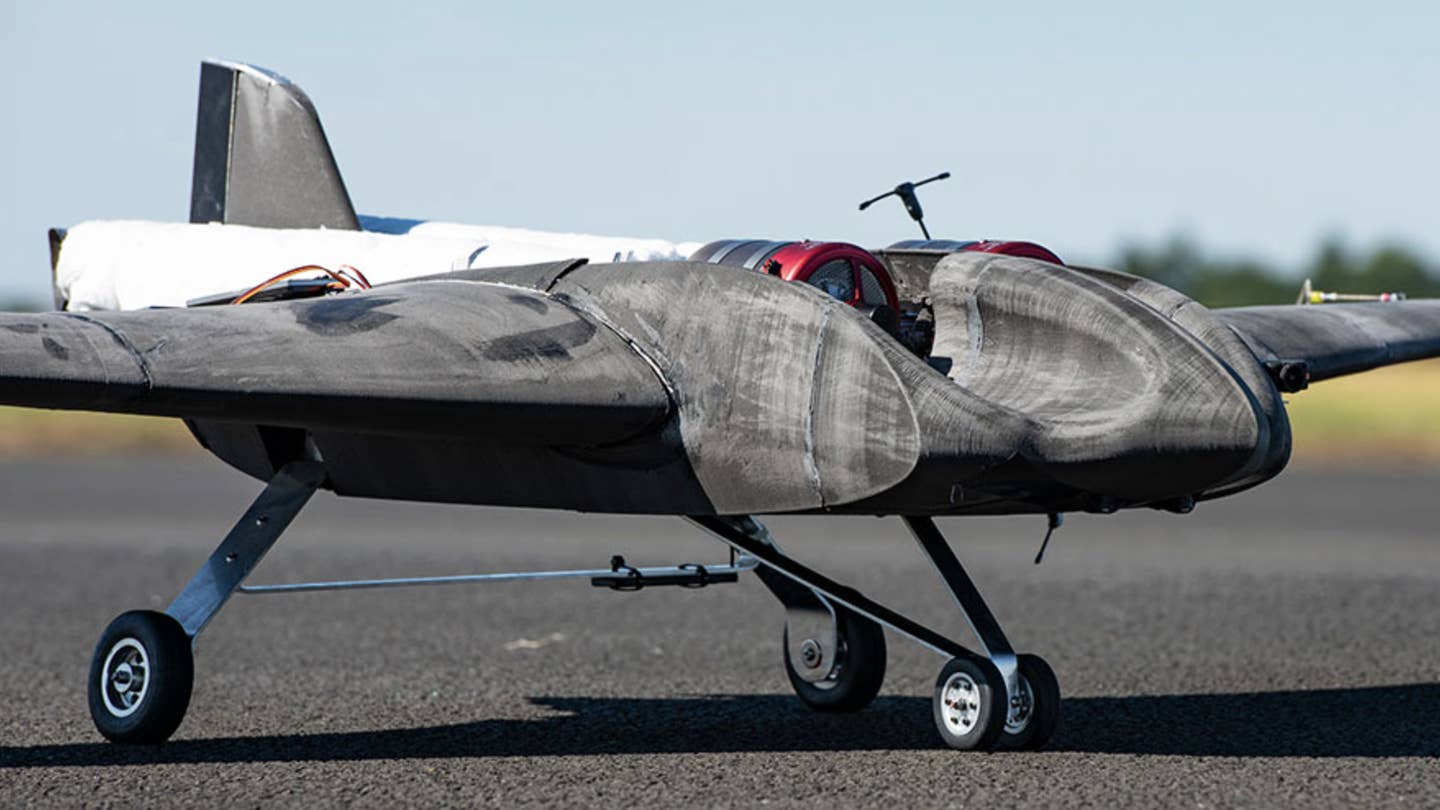
In an until-now secretive program, the United Kingdom has rapidly developed and flight-tested a number of “complex” drones that would be suitable for use by Ukraine in its conflict with Russia. While it’s unclear which of any of the unmanned aircraft systems (UAS) in question were ultimately selected for supply to Ukraine, it’s obvious that a range of different capabilities was explored in the process, including surveillance drones and, most intriguingly, what is described as a “3D-printed delta-wing ‘suicide’ drone.”
Some details of the rapid development program were recently revealed by QinetiQ, the U.K.-based defense technology company that works closely with the U.K. Ministry of Defense, especially on experimental projects and novel technologies. The drone program originated in the Future Capability Group — part of the defense ministry’s Defense Equipment and Support (DE&S) branch — which, in turn, engaged QinetiQ.
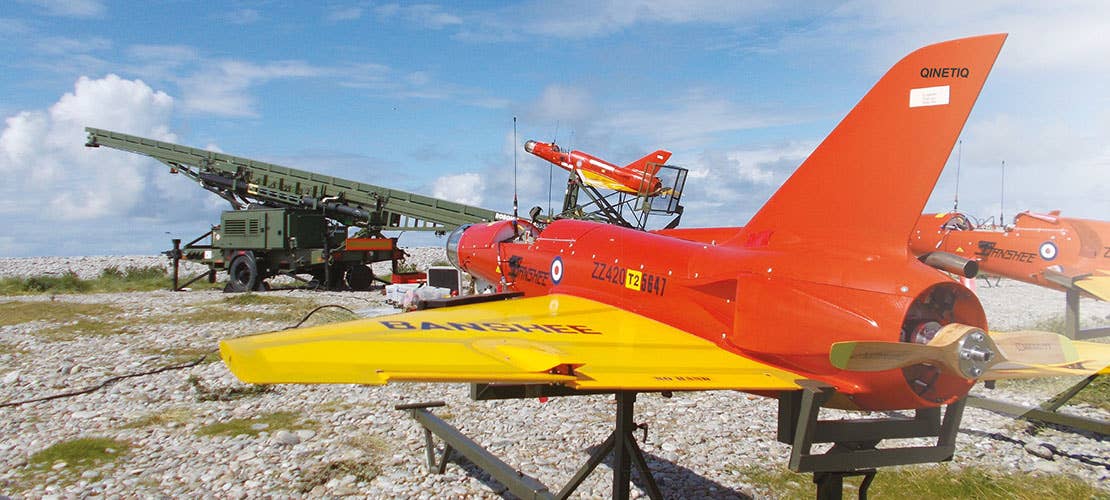 Another drone in the QinetiQ portfolio, the Banshee Whirlwind remotely piloted aerial target. QinetiQ
Another drone in the QinetiQ portfolio, the Banshee Whirlwind remotely piloted aerial target. QinetiQA statement from QinetiQ doesn’t confirm when the program actually took place, while an uncaptioned accompanying photo (also seen at the top of this story) shows a small drone with swept wing and tail fin, apparently powered by a pair of micro-turbine engines, and possibly 3D-printed. The suggestion is that this is one of the prototypes from the program, but that also remains unconfirmed for now. On both counts, we have approached the company to find out more.
The aim of the program was to “provide recommendations for uncrewed aircraft systems that could be deployed readily by the Ukrainian military” and was part of a wider U.K. government effort, known as KINDRED, that’s assessing what kinds of weapons and equipment could potentially be introduced to service by Ukraine in the space of just four months.
Within “a few weeks,” according to QinetiQ, it was determined that the drone program would be run from the company’s sprawling MOD Boscombe Down test site, in southwest England. Here, efforts were made to set up a safe and effective “sandbox window” test environment on the airfield.
But while KINDRED explores potential new defense equipment for Ukraine that can be brought to the front line within four months, the drone program was run on a much more demanding timeline. Within just three weeks, the QinetiQ-led team was to demonstrate a series of new drones and related technology to senior U.K. Ministry of Defense officials, during a two-day event. This would include “flying experimental UAS and EW [electronic warfare] testing.”
The QinetiQ Obsidian radar, offered as a counter-drone solution:
Ultimately, the defense ministry officials observed equipment, systems, and technologies from five different companies that were demonstrated at Boscombe Down. According to QinetiQ, the test projects “included C2 [command and control] and sensor payload[s] as well as VTOL [vertical takeoff and landing] UAS and a unique 3D-printed delta-wing ‘suicide’ drone.” No details of other projects were disclosed and the companies involved have not been named.
We do know, however, that there was close involvement from a range of U.K. defense organizations and units, including the Royal Air Force (RAF) Rapid Capabilities Office (RCO), the Royal Navy, the RAF’s No. 56 Squadron, Royal Artillery, Defense Science and Technology Laboratories (DSTL), U.K. Strategic Command, and the British Army HQ, as well as the Future Capability Group and DE&S.
As well as flight tests of at least some of the rapidly developed drones, the trials also included experiments on the ground, and use was also made of Boscombe Down’s anechoic test facility, which can be used to assess how test specimens respond to radio-frequency energy, as well as providing a controlled environment to see how electronic systems and emissions interact with one another. The anechoic chamber was also used to expose the test specimens to command link jamming, an important consideration in Ukraine considering Russia’s widespread use of offensive electronic warfare.
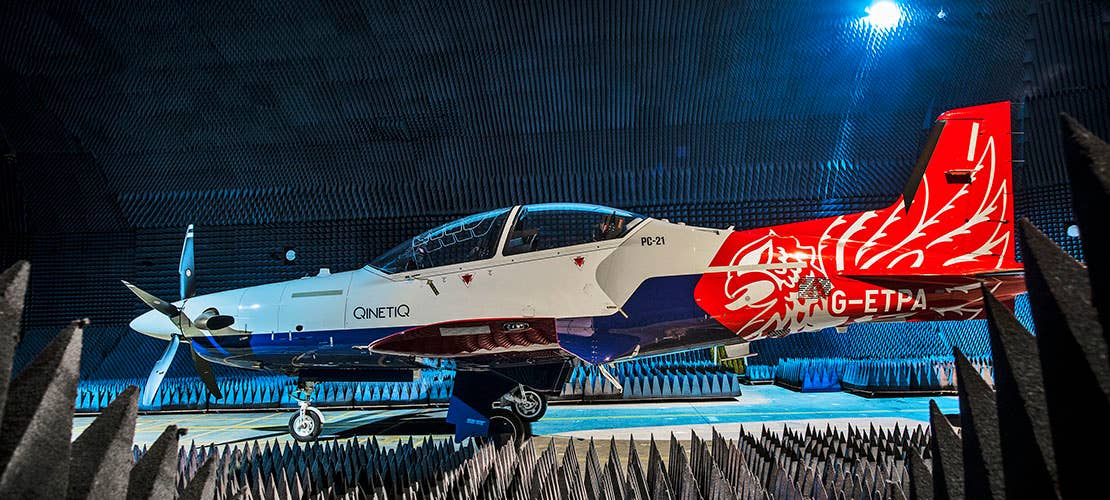 A company-operated PC-21 turboprop trainer in QinetiQ’s anechoic test facility. QinetiQ
A company-operated PC-21 turboprop trainer in QinetiQ’s anechoic test facility. QinetiQIt is worth noting that QinetiQ has also been playing a central role in developing new UAS technologies for the U.K. Royal Navy, including producing the jet-powered Banshee Jet 80+ that has been launched from the deck of the aircraft carrier HMS Prince of Wales. The adapted target drone has been used to demonstrate the broader potential for flying future adversary missions as well as more capable operational UAS that could be used aboard the two Queen Elizabeth class carriers. A Banshee development would also appear to be suitable for adaptation as a ‘suicide’ drone, should that be desired. At the very least, it would seem likely that work with the Banshee could have informed the designs developed for Ukraine.
The development program in the United Kingdom seems to have some parallels with the U.S. effort to develop the still-mysterious Phoenix Ghost loitering munition for Ukraine. This all-new weapon was quickly developed by the U.S. Air Force specifically for Ukraine and, although announced as part of a U.S. security assistance package in April last year, the weapon is not thought to have been identified in use so far.
The big question is to what degree the results of the U.K. drone experiment led to technologies that were selected for Ukraine and whether these might have even been used on the battlefield already. QinetiQ has only said that the event “delivered invaluable UAS insight and assurances to support the provision of effective equipment for the Ukrainian military.”
At the same time, while the United Kingdom is known to have transferred a considerable number of drones to Ukraine — at least 2,000, including loitering munitions — as part of its aid effort to that country, there have been few details as to the particular types supplied. It is possible that at least some of the drones supplied already are of types or configurations that were specifically designed for Ukraine.
Some of the drones provided to Kyiv by the United Kingdom so far include “unmanned surveillance systems” of unknown type, cargo-carrying logistics drones, autonomous mine-hunting vehicles, as well as 850 hand-launched Black Hornet micro-drones, the latter as part of a deal in collaboration with the Norwegian Ministry of Defense.
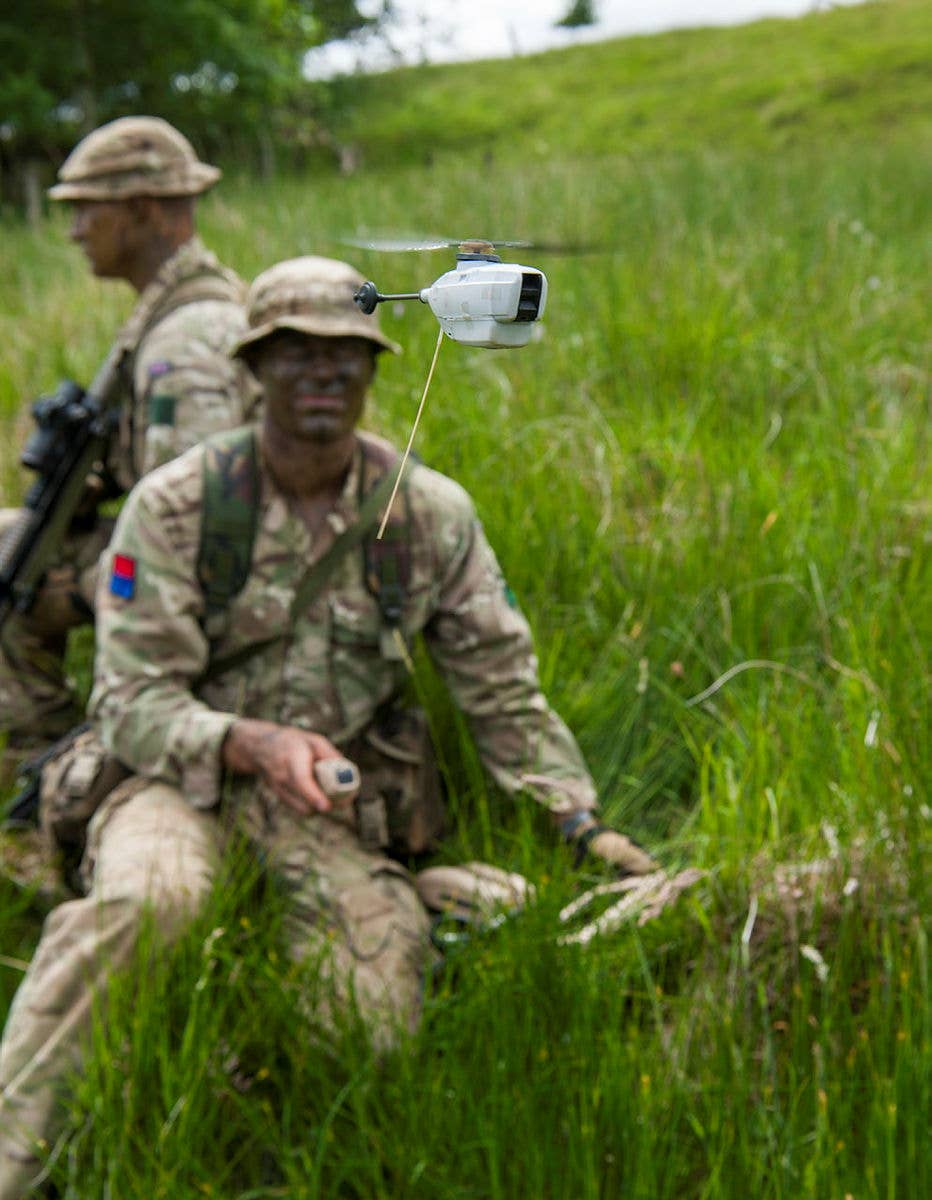
A British Army Black Hornet micro-drone. Crown Copyright
To date, the United Kingdom is not known to have delivered any armed drones, although the fact that a delta-wing ‘suicide’ drone has at least been tested, with a view to supplying it to Ukraine, is significant.
In fact, Ukrainian efforts to field a ‘suicide’ drone in broadly the same class as the Iranian-designed Shahed-136 used by Russia may well be gaining momentum.
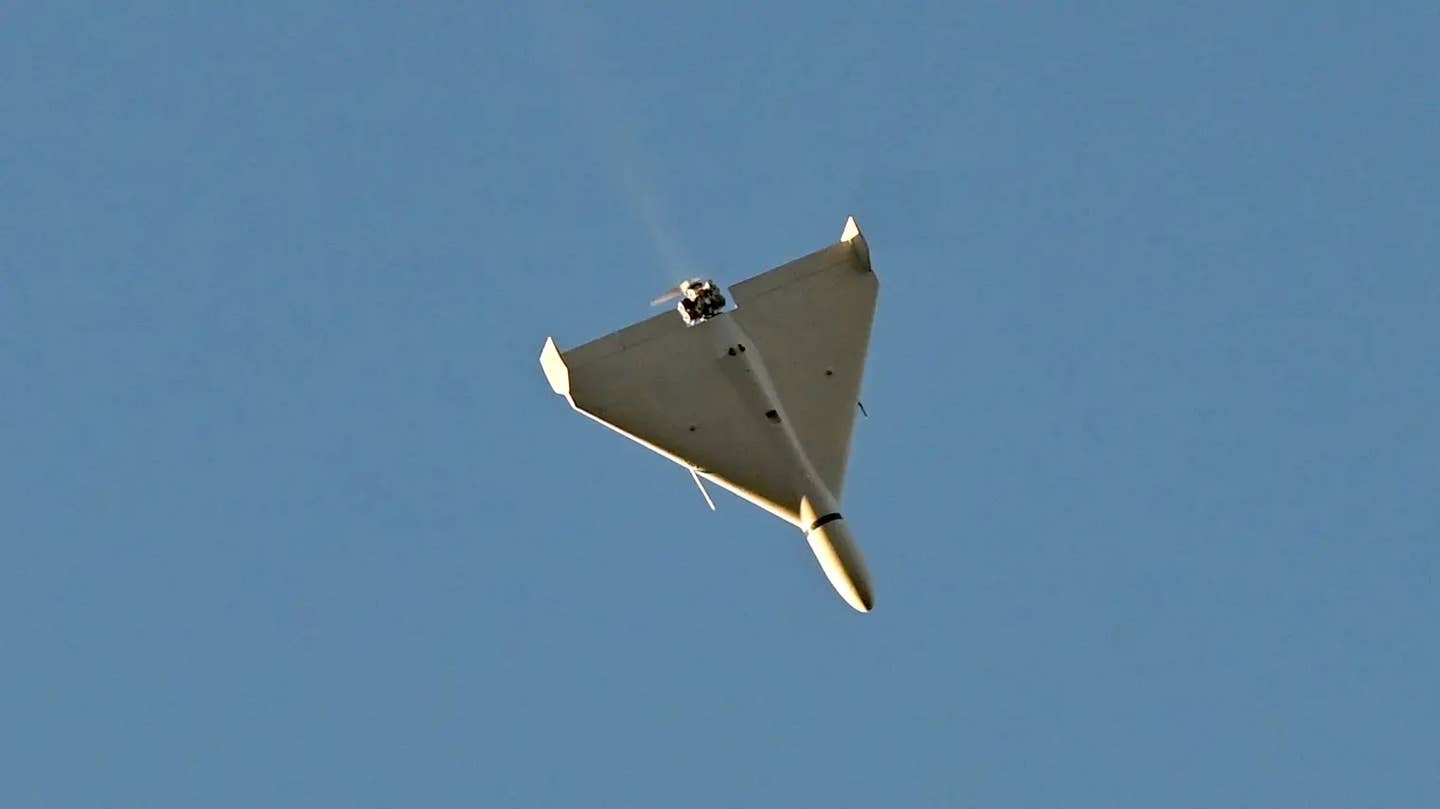 A Russian-operated Shahed-136 over Ukraine. SERGEI SUPINSKY/AFP via Getty Images
A Russian-operated Shahed-136 over Ukraine. SERGEI SUPINSKY/AFP via Getty ImagesA brief video that emerged on social media within the last week shows what’s apparently a modified version of the RZ60, which was originally developed in Ukraine as a target drone. The new version uses a trailer-mounted rocket-assisted launch system, instead of the previous pneumatic catapult. There is speculation that the drone is intended for one-way attack missions, although that cannot be said for certain, and details such as range and payload remain unclear.
What we do know is that Ukraine has adapted other kinds of drones for ‘suicide’ missions, including off-the-shelf hobby-style drones that have been used to target objectives in Crimea and across the border in Russia.
If the Ukrainian military were to go forward with this U.K.-developed drone as a strike weapon, it would give them another method of hitting Russian forces at longer ranges, though not nearly as far as some of its strikes with the Soviet-era jet-powered Tu-141 Strizh reconnaissance drone that Ukraine has converted into a strike platform and that’s hit targets deep inside of Russia.
For the time being, there is no confirmation that the RZ60 is indeed being adapted as a ‘suicide’ drone, although a weapon in this class would almost certainly be of great interest to Ukraine and that would appear to be reflected in the testing of a delta-wing ‘suicide’ drone in the United Kingdom.
Depending on the performance of the 3D-printed delta-wing drone tested at Boscombe Down, it’s even possible that it could be the weapon referred to recently by U.K. officials when they said they plan to offer Ukraine “longer-range capabilities,” which led to some speculation that the Storm Shadow cruise missile could be headed to Ukraine.
The U.K. government said the weapons in question “will disrupt Russia’s ability to continually target Ukraine’s civilian and critical national infrastructure and help relieve pressure on Ukraine’s frontlines.” That could well make sense as a reference to a British-designed ‘suicide’ drone, but for now, we simply don’t know.
The cost factor could also be important for any kind of drone rapidly developed for Ukraine, especially one that makes use of 3D printing. While a low price point was not one of the criteria mentioned for the U.K. drone experiment, a UAS of this kind could potentially offer a much cheaper way of striking Russian targets at distance, or even overwhelming Russian air defenses if launched in considerable numbers. At the same time, the 3D printing method should allow the drone to be designed and developed in the United Kingdom, before production is launched in Ukraine, with only minimal preparation required.
Of course, longer-range weapons are one of the critical items of military aid that Ukraine is now vigorously campaigning for — alongside new fighter jets. To what degree there may be a connection between the U.K.’s drone experiments and potential new-long-range strike weapons for Ukraine remains speculative for now, but drones, more generally, are clearly something that the United Kingdom is putting a significant emphasis on as it seeks to put additional and more effective weapons in Kyiv’s hands. It will be fascinating to see whether any of these technologies appear on the battlefield any time soon.
No comments:
Post a Comment